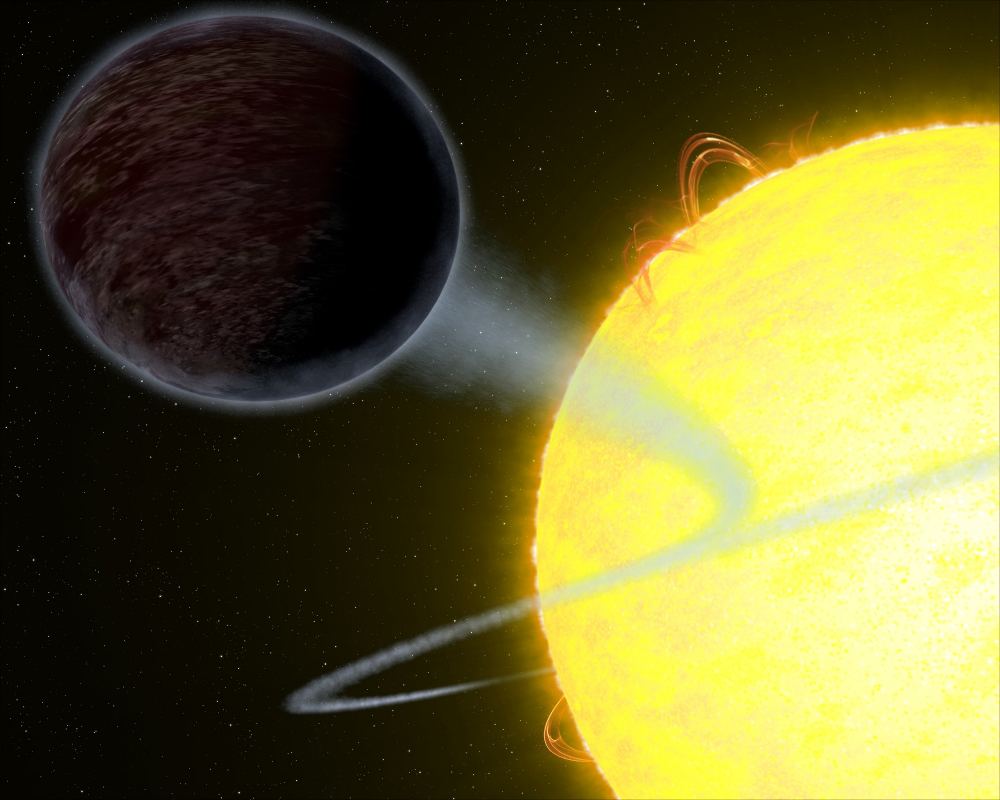Exoplanets are a fascinating astronomy topic, especially the so-called “Hot Jupiters”. They’re overheated massive worlds often found orbiting very close to their stars—hence the name. Extreme gravitational interactions can tug them right into their stars over millions of years. However, some hot Jupiters appear to be spiraling in faster than gravity can explain.
WASP-12b is a good example of one of these rapidly spiraling hot Jupiters. In about three million years, thanks to orbital decay, it will become one with its yellow dwarf host star. Both are part of a triple-star system containing two red dwarf stars. The hot Jupiter orbits the dwarf in just over one Earth day at a distance of about 3.5 million kilometers. That’s well within the orbit of Mercury around the Sun. Thanks to that orbit and gravitational influence, one side of the planet always faces the star. That heats only one side and puts the surface temperature at about 2,200 C. Eventually heat flows to the opposite side, which stirs up strong winds in the upper atmosphere. The planet doesn’t reflect much light, and astronomers have described it as a pitch-black world.
As if all that isn’t odd enough, the gravitational pull of the nearby star distorts this hot Jupiter into an egglike shape. It’s also stripping the planet’s atmosphere away. So, it’s no wonder astronomers described WASP-12b as a doomed planet.

What’s Tugging on Hot Jupiters?
According to conventional theory, a hot Jupiter planet like WASP-12b should create strong gravitational tidal waves between themselves and their parent stars. Those waves transfer energy, which tugs at the planet. That pulls the planet right into the star. Such a fiery death is definitely in WASP-12b’s future. But, there’s just one problem: it’s getting sucked in faster than gravitational tidal waves can explain. What’s happening?
A team of scientists at Durham University in England studied WASP-12b and they’ve come up with an interesting idea. What if this hot Jupiter’s fate is determined by magnetic fields? That’s what Durham’s Craig Duguid proposed in a recently published paper. Duguid’s team thinks the strong magnetic fields inside some stars can dissipate the tidal waves generated by orbiting hot Jupiters.

How this works isn’t completely confirmed yet, but here’s the basic idea. Inwardly propagating internal gravity waves (IGWs) (such as those from the nearby hot Jupiter) move through a star. They eventually run into the star’s magnetic interior. If that magnetic field is strong enough, it transforms them into magnetic waves. They move back outward and eventually dissipate. In the process, however, that dissipation causes a huge energy drain. The result is still the same as with gravitational tidal waves: the hot Jupiter loses energy and plows into its parent star. And, it could explain why some hot Jupiters spiral into their stars more quickly than expected.
Exploring the Magnetic Mechanism Idea
In the paper, Duguid and his team used models of stars with convective cores—such as F-type stars with masses between 1.2 to 1.6 solar masses. Astronomers suspect these experience weak tidal dissipation. The team used the known properties of these stars’ interiors, along with estimates of their magnetic fields. For these stars, a convective core is the dynamo that generates the magnetic field. Although it’s classified as a type-G star, WASP-12 fits into the study, thanks to its near-solar mass and radius.
So, is it just gravitational tidal waves pulling the planet in, or could the proposed magnetic field action be at work? Duguid and colleagues concluded that the magnetic field idea is very possible. They write, “Our main result is that this previously unexplored source of efficient tidal dissipation can operate in stars within this mass range for significant fractions of their lifetimes. This tidal dissipation mechanism appears to be consistent with the observed inspiral of WASP-12b and more generally could play an important role in the orbital evolution of hot Jupiters—and to lower-mass ultra-short-period planets—orbiting F-type stars.”
Need More Data about Hot Jupiters
It’s an interesting result. There are a great many hot Jupiters in the exoplanet archives, simply because they are the easiest exoplanets to observe. Some of them are spiraling in faster than expected. This leads the authors to suggest that additional studies of similar-type stars and their hot Jupiters could confirm the magnetic mechanism. In addition, future observations could help astronomers also understand the tidal wave theory and help place some constraints on the types of stars where it would operate.
For More Information
Scientists Explain Why Some Exoplanets are Spiraling Towards Their Stars
An Efficient Tidal Dissipation Mechanism via Stellar Magnetic Fields

